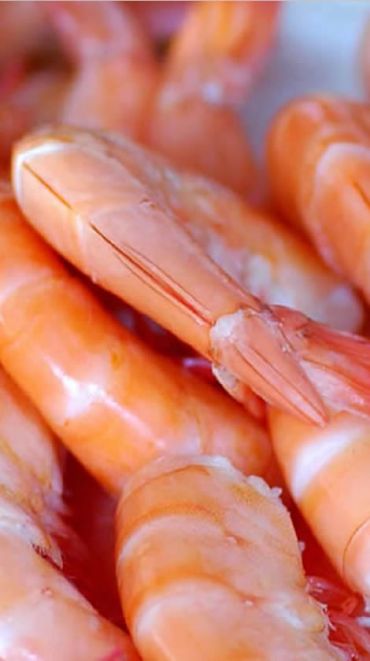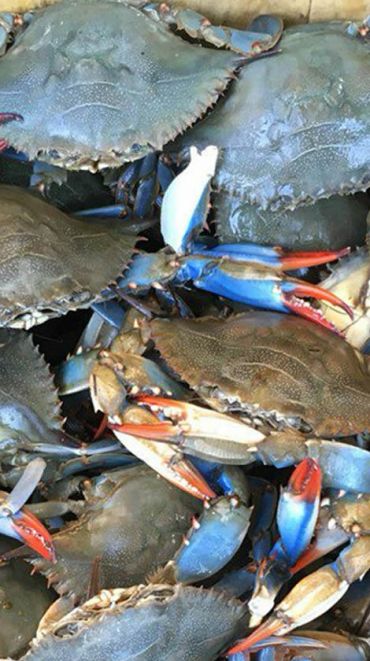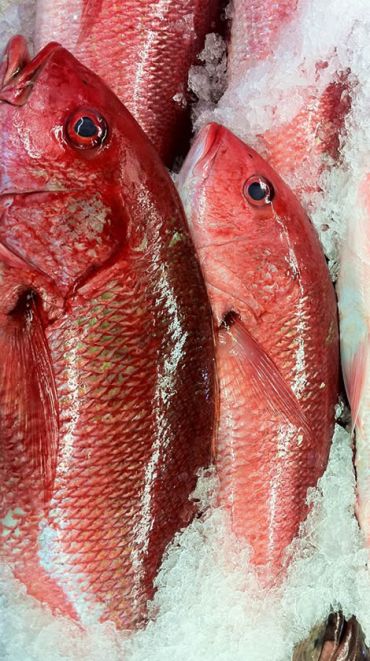Our oysters are shucked and sold in both pints and quarts. All of our oysters come from state approved waters and shucked in licensed and inspected facilities. The oyster season runs from September into the beginning of May. The old adage of eating oysters only in months with an "R" was before the days of adequate refrigeration, but they do taste better in the colder months.
Also they are potentially more dangerous in the warmer months if eaten raw, so we don't carry them during the summer months. (See below more info on eating raw oysters).
The Eastern oyster, the kind that we carry, is known for its distinctive, salty flavor and meaty texture. Cooked meat turns ivory. They can be fried, baked, steamed, broiled or micro-waved and can be served as appetizers, main dishes, side dishes or salads. Oysters are tender creatures. They should never be heated too quickly or too long. Oyster stew attests to the delicious flavor of the cooked oyster in its own broth.
The cultivation of oysters began more than 2,000 years ago with the Romans and people's passion for them persists today.
 Oysters flourish in estuaries where nutrient-rich fresh water meets the salt water and feed mainly on single-cell plants. When feeding, the oyster can pump and filter 25 gallons of water in 24 hours. Estuaries provide suitable conditions and a plentiful food supply for Eastern oysters (Crassostrea virginica) to grow rapidly. They can reach marketable size in less than two years; whereas, it may take oysters up to six years to reach marketable size in colder northern waters. Today, two-thirds of the national oyster harvest is Eastern oysters. While Pacific oysters are mostly cultivated, Eastern oysters are harvested mainly from wild beds. Eastern oysters have a moderately deep, elongated, gray-white to gray-brown, rough, spoon-shaped shell with rose-colored streaks. Inside is a light-colored fringe (the gill) and creamy to light-brown meat. When traveling along the Gulf coast, you may see oysters being harvested commercially from small boats by fishermen using large, long handled tongs to scoop clumps of oysters from the bottom.
Oysters flourish in estuaries where nutrient-rich fresh water meets the salt water and feed mainly on single-cell plants. When feeding, the oyster can pump and filter 25 gallons of water in 24 hours. Estuaries provide suitable conditions and a plentiful food supply for Eastern oysters (Crassostrea virginica) to grow rapidly. They can reach marketable size in less than two years; whereas, it may take oysters up to six years to reach marketable size in colder northern waters. Today, two-thirds of the national oyster harvest is Eastern oysters. While Pacific oysters are mostly cultivated, Eastern oysters are harvested mainly from wild beds. Eastern oysters have a moderately deep, elongated, gray-white to gray-brown, rough, spoon-shaped shell with rose-colored streaks. Inside is a light-colored fringe (the gill) and creamy to light-brown meat. When traveling along the Gulf coast, you may see oysters being harvested commercially from small boats by fishermen using large, long handled tongs to scoop clumps of oysters from the bottom.
Oysters are high in minerals and one of nature's richest sources of iron, more than calf's liver; eight ounces provide 13.2 milligrams or 73% of the maximum adult daily iron requirement (18 milligrams). They contain as much of the trace elements as meat from domestic animals and more than vegetables and dairy products. The protein in oysters is of high quality and is more digestible than beef or chicken.
Store fresh, shucked oysters on ice or in the coldest part of the refrigerator and use within five days of purchase. You can freeze oysters in the containers we sell them in, but make sure to drain a bit of the juice first to prevent the lid from popping. Or freeze in an airtight container. You can freeze them for several months but its better to cook them afterwards (raw oysters are better eaten fresh). Thaw them in the container under cold running water or in the refrigerator. Never refreeze.
There is risk associated with consuming raw oysters for people with compromised immune systems. If you have chronic illness of the liver, stomach, blood, diabetes or other immune disorders, you are at greater risk of serious illness from raw oysters and should eat oysters fully cooked. If unsure of your risk, consult a physician.
Cathy Z. Hollomon of the Coastal Research and Extension Center in Biloxi, Mississippi, in her web article entitled "Information For People Who Love To Eat Oysters", writes:
"There has been a lot of concern about the potential health hazards associated with eating oysters. Although there is always a slight health risk associated with eating raw or partially cooked oysters, the risk for a health adult is minimal. The concern exists because certain people can develop a severe and potentially fatal infection from a bacteria called Vibrio vulnificus.
Most people will not develop this infection; however certain medical conditions place some people in a "high risk" category for contracting this bacterial infection. For these individuals, infection can cause serious illness or even death. People with weakened immune systems should always eat thoroughly cooked oysters and never eat them raw or partially cooked. The bacteria is completely killed if thoroughly cooked."
"Conditions that place people in a high risk category for contracting a potentially fatal infection include:
- Liver disease, either from excessive alcohol intake, viral hepatitis or other causes,
- Hemochromatosis, an iron disorder,
- Cancer (especially if taking anti-cancer drugs or radiation treatment),
- Lymphoma, leukemia, AIDS, Hodgkin's disease,
- Diabetes mellitus,
- Chronic kidney disease,
- Inflammatory bowel disease (or any person receiving immunosuppressive drugs),
- Steroid use or dependency (as for asthma and arthritis, or for conditions such as chronic obstructive pulmonary disease etc),
- Stomach problems, including previous stomach surgery and low stomach acidity (for example, from antacid use),
- Immune disorders, including HIV infection."
"With age, the probability of developing any of the above conditions increases. Older adults should, therefore, pay particular attention to the "high risk" conditions and act responsibly."
"So what is Vibrio vulnificus? Vibrio vulnificus is a bacteria that occurs naturally in the marine environment and is commonly found in warm, coastal waters like those characteristic of the Gulf of Mexico. Because it is not the result of pollution by animal or human fecal waste, it can be present in waters approved for the legal harvest of oysters and clams. So, regardless of the source of the oysters (clean or polluted waters, or open or closed reefs) the potential for infection still exists. Vibrio vulnificus may even continue to multiply within the oysters after they are harvested. Presence of the bacteria is difficult to detect because it causes no change in the appearance, taste, or odor of oysters. Only laboratory analysis can determine if the oyster is contaminated with Vibrio vulnificus."
"Infection from Vibrio vulnificus does not rank statistically as a major public health issue for the population as a whole but it remains a very serious issue for high-risk individuals. Reports of illnesses and infection associated with Vibrio vulnificus are most prevalent during the warm months of the year when the bacteria can flourish, primarily April through October. In fact, 88% of all reported Vibrio vulnificus infections occurred between May and October. Individuals that are considered high-risk, however, should not eat raw shellfish any time of the year as it can mean the difference between life and death."
"Infection from Vibrio vulnificus generally occurs through ingestion of contaminated raw or undercooked seafood, especially oysters, but can also occur b direct contact with open wounds while swimming, cleaning shellfish, or participating in other marine activities. Symptoms of infection usually occur within 16 hours of ingesting the organism and may include one or more of the following: nausea, chills, vomiting, diarrhea, confusion, weakness, cellulitis, and enlarged blood-filled or clear blisters, most often on the legs. Ingestion of raw or undercooked shellfish contaminated with Vibrio vulnificus can lead to primary septicemia (invasion of the bloodstream with pathogenic bacteria) or gastroenteritis (inflammation of the stomach or intestines). Everyone is susceptible to gastroenteritis. This illness is generally not fatal in healthy individuals. However, high-risk individuals frequently develop the "primary septicemia" form of this disease. The mortality rate for individuals with this form of the disease is over 50% and generally occurs within 2-3 days of onset of the illness."
"It is important to note that no major outbreaks of illness have been attributable to Vibrio vulnificus. Sporadic cases of infection occur, becoming more prevalent during the warmer months. This is a very serious disease particularly for high-risk individuals. Good sense should always be exercised. To avoid risking illness, always fully cook oysters and other shellfish."




